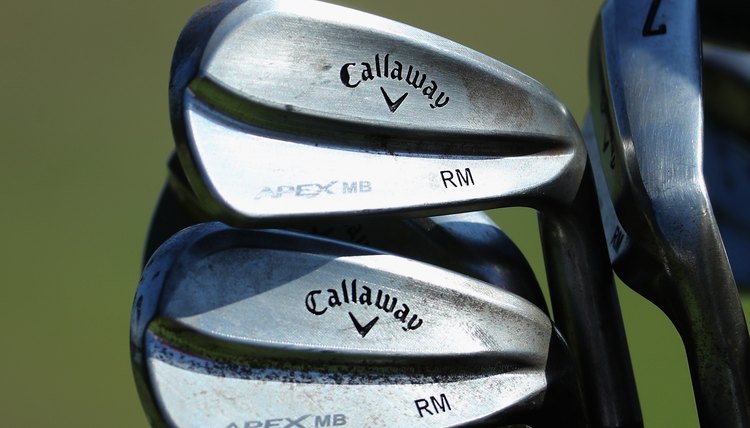Degrees of Loft in Pitching Wedges

The pitching wedge was once the club of choice for a variety of approach shots. When a golfer was beyond sand-wedge distance, but needed more loft than a 9-iron offered, he reached into his golf bag for the versatile pitching wedge. With the advent of gap and lob wedges, the pitching wedge now has greater competition. But as important as the short game is, a pitching wedge remains an important part of most golfers’ arsenals.
Understanding Loft
Loft is the angle of the clubhead relative to the club’s shaft.
As the angle increases, the club’s loft increases. Higher-lofted wedges – including the pitching wedge – make it easier to lift the ball high in the air, but all else being equal the ball won’t travel as far as it will when hit with a lower degree wedge.

Different Types of Golf Wedges
When a 9-iron is too much club for an approach shot, it’s time to look past the iron set of golf clubs and choose a wedge.
Like a set of irons, there are a few different types of wedges that each have different lofts, allowing them to be useful in a number of situations where you find your golf ball in- whether that is on the fairway or lining up a bunker shot.
The most lofted clubs in the wedge set are good for hitting the ball more vertical in the air with less distance, and wedges with less loft on their leading edge are good for closing the distance gap between where the ball lies and where you want it to go.
The four types of golf wedges are:
- Pitching wedge
- Gap wedge (or approach wedge)
- Sand wedge
- Lob wedge

The Pitching Wedge
The pitching wedge is the least-lofted of the wedge family, so you’ll hit the ball farther than with a gap, lob or sand wedge. Your exact pitching-wedge yardage range depends on your personal golf game when you’re out there on the golf course.
Former PGA Tour standout Tom Watson reported in 2008, at age 59, that he hit his pitching wedge 125 yards, so an average male golfer might employ the club for shots of 100 to 110 yards, and beginner golfers slightly less than that.
You can also use it for shorter shots when you must clear an obstruction between the ball and the green, when the ball is against the collar of the green or for other approaches when a chip shot isn’t an option. You’ll generally use a pitching wedge with a good-to-fair lie.
Pitching Wedge Loft
Pitching-wedge lofts vary a bit with different club manufacturers.
The minimum loft you’re likely to find on a pitching wedge is 43 degrees. Unless you discover an antique from the pre-gap wedge days, you probably won’t find a true pitching wedge with a loft of more than 50 degrees. A typical pitching wedge today features 45 to 48 degrees of loft.
Other Wedges
Gap wedges literally fill the gap between the pitching wedge and the sand wedge, which usually features a 56-degree loft. Gap wedges typically contain 50 to 54 degrees of loft. Gap wedges are used close to the green, allowing players to take a full swing. Before gap wedges were invented, golfers often employed the pitching wedge for very short approaches where chipping wasn’t possible. The player would take an abbreviated backswing to avoid hitting the ball too far.
Sand wedges, as you may guess, are the perfect club in the wedge set to use when you need to get out of a sand trap and the rough.
Lob wedges are the most high lofted wedge, generally 58 to 60 degrees, which is a big difference compared to the sand wedge loft of about 45 to 48 degrees. Lob wedges are used for short shots and pitch shots in which the ball must rise immediately and land on the green softly. A few manufacturers even offer lob wedges of up to 64 degrees in loft.
Writer Bio
M.L. Rose has worked as a print and online journalist for more than 20 years. He has contributed to a variety of national and local publications, specializing in sports writing. Rose holds a B.A. in communications.
